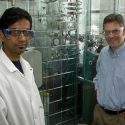WARF commits $80 million to BioStar
The Wisconsin Alumni Research Foundation has pledged $80 million to the university’s BioStar Initiative over the life of the 10-year bioscience building project.
The funding commitment marks the largest single gift in WARF’s 75-year history, and puts BioStar on a fast track only five months after Gov. Tommy Thompson debuted the public-private initiative.
|
Related graphics: Maps of the current biosciences campus and the proposed campus under the BioStar Initiative
Related resource:
Related Web site: |
BioStar ultimately will help the university modernize research and teaching space in the biosciences, and is expected to spark continued growth in the state biotechnology business sector.
“This gift is a tremendous investment in the future of Wisconsin and the University of Wisconsin,” Thompson says. “We are poised to become the nation’s leading biotechnology center — in terms of both research and job creation.”
WARF’s Board of Trustees voted in May to approve the funding commitment of up to $80 million, and WARF and university officials recently completed details of the gift. WARF is the not-for-profit patenting and licensing agency for UW–Madison, overseeing more than 800 industry licenses of UW–Madison technology and roughly $1 billion in investments.
“This represents a quantum leap forward in our efforts to make BioStar a reality,” says Chancellor David Ward. “WARF’s gift will help us finally move from aging, outmoded buildings to space that meets the demanding standards of these cutting-edge fields.”
The biosciences are one of UW–Madison’s fastest-growing and most research-intensive fields, spanning 2,000 graduate students, 800 faculty and 60 academic departments. A recent survey revealed nearly one in every three new freshmen in 1999-2000 plan to major in a biology-related field of study.
The $317 million building project unveiled by Gov. Thompson requires a 50-50 funding split between the state and the university through private fund-raising, and the WARF gift accounts for more than half of UW–Madison’s share.
Carl Gulbrandsen, managing director of WARF, says trustees first began considering support for BioStar in February. The board appointed a subcommittee, led by retiring trustee Wayne Roper, to study the need for the facilities and the economics of such a gift. The subcommittee also toured some of the aging facilities slated for replacement, such as E.B. Fred Hall and old Biochemistry. The consensus, Gulbrandsen says, was that the BioStar program is sorely needed.
“The gift recognizes the quality of research at the university and the great potential for the future,” Gulbrandsen says. “It is also a great way to recognize the 75th anniversary of WARF.”
Gulbrandsen says WARF has typically not supported building projects in the past, noting its original charter stipulates that royalties be channeled directly back into campus research. WARF is the oldest – and one of the largest – intellectual property organizations in America representing a university.
But in this new era of technology-driven science, Gulbrandsen says trustees recognized that quality research and facilities are inextricably linked.
“We recognize that BioStar is complimentary to the university’s overall goals,” he says. “You’re not going to attract world-class faculty to come to Madison without exceptional facilities. There was a strong feeling on the board that this was long overdue, and a good investment in science.”
WARF trustees also were convinced that the BioStar investment would not interfere with existing funding commitments to the university, Gulbrandsen says. Those include an annual grant to the UW–Madison Graduate School in the range of $25-$30 million per year; and $5 million annually to support the Madison Initiative.
Although separate campaigns, BioStar and the Madison Initiative are complimentary in supporting the university’s future. Strategic faculty hiring efforts under the Madison Initiative have brought new bioscience faculty to campus, placed more funding in basic biology education and created new programs to promote technology transfer.
BioStar ‘s first public vote of approval came May 2 when the State Building Commission approved planning funds for the Biotechnology Addition. The BioStar package, enumerated as a four-building, 10-year project, will be part of the governor’s 2001-2003 capital budget for consideration by the state Legislature.
Gov. Thompson’s initiative, unveiled during his January State of the State address, looks to this building initiative as a catalyst for further biotechnology growth statewide, particularly in the Madison-Milwaukee corridor. In the past decade alone, more than 100 new technology-based firms with UW–Madison research ties have formed in Wisconsin.
The four buildings proposed under BioStar would all be located near the Henry Mall area of campus.
Here are the major projects:
- The Biotechnology Center addition will provide space for the new Genome Center of Wisconsin, and eventually replace the antiquated Genetics Building next door at 445 Henry Mall.
- A new Microbial Sciences building would replace the E.B. Fred Building, 1550 Linden Drive, and provide an academic center for the microbiology, immunology and food safety departments.
- A Biochemistry building renovation would almost completely replace the existing century-old building on Henry Mall and provide teaching and research space that matches the quality of the 1998 biochemistry addition.
- A new Interdisciplinary Sciences building would be a campuswide resource that focuses on collaborative approaches to undergraduate and graduate education. Several locations are being considered.
WARF’s commitment will give the UW Foundation a substantial head start in upcoming fund-raising campaigns devoted to BioStar. Sandy Wilcox, president of the UW Foundation, says that BioStar will be a major component of the foundation’s ongoing fund-raising effort.
Tags: biosciences, research



